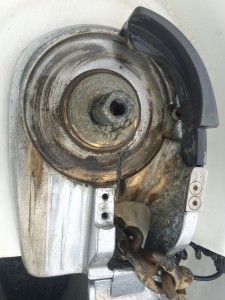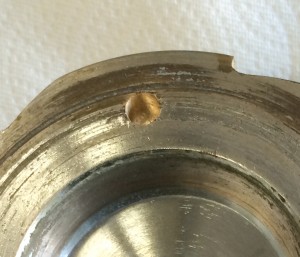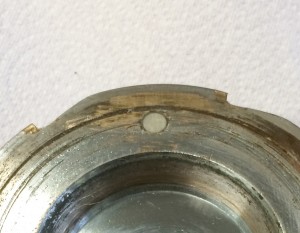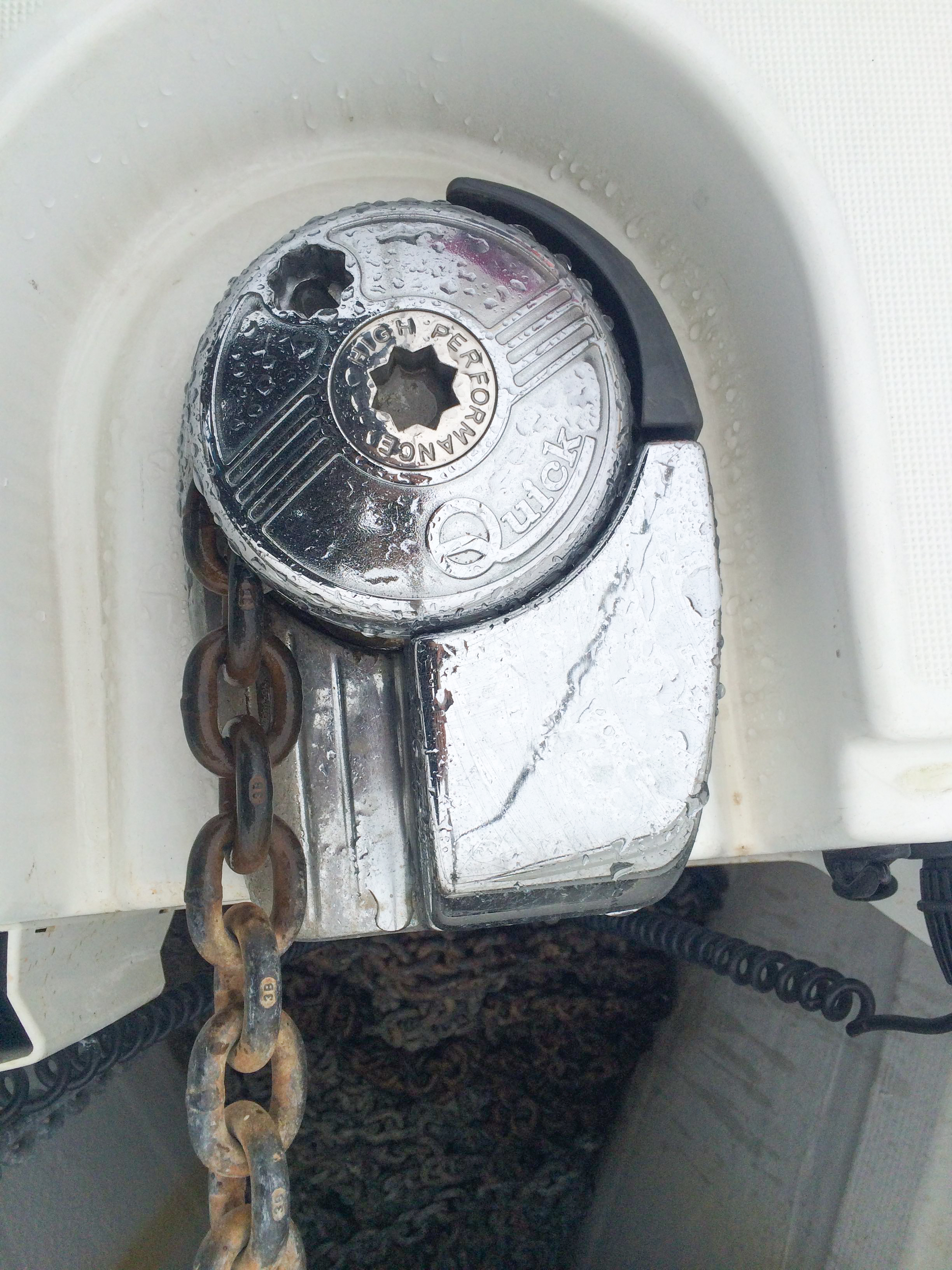The Chain Counter that Couldn’t Count
One of the little problems we found on Mobert after purchasing her was that our Quick Chain Counter didn’t count. It always shows 0.0 no matter how much chain we’ve put out. Since I generally like things to work as designed, this issue was put on my list of things to work on over the winter. Initially I assumed that there was a broken wire somewhere but I realized that it was going to be a fairly significant effort to trace the wire from the bow to the stern through all the hidden parts of the boat. This didn’t really sound like fun. So I put it off.
Later in the fall I decided to try removing the windlass gypsy to see if I could find and test the sensor for the counter. So with about an  hour of free time one afternoon I remove some screws and the cover and pulled the gypsy off. At first I couldn’t find a sensor or the magnet but after wiping some grease away I finally found them. The sensor sits flush in the base of the windlass and the magnet (if it was still there) appeared to be in a hole on the bottom of the gypsy. As a test, I took an telescoping magnet and passed it over the sensor a number of times, and sure enough the counter started counting up. So the wiring works, the counter works, and the sensor works. Which means the only thing that is not working is the magnet — how does a magnet stop working?
hour of free time one afternoon I remove some screws and the cover and pulled the gypsy off. At first I couldn’t find a sensor or the magnet but after wiping some grease away I finally found them. The sensor sits flush in the base of the windlass and the magnet (if it was still there) appeared to be in a hole on the bottom of the gypsy. As a test, I took an telescoping magnet and passed it over the sensor a number of times, and sure enough the counter started counting up. So the wiring works, the counter works, and the sensor works. Which means the only thing that is not working is the magnet — how does a magnet stop working?

Turns out.. It stops working by rusting away. From what I can tell, at some point in the past, the epoxy over the magnet was compromised, possibly by dirt and grime between the gypsy and the base, and water/saltwater got to the magnet. So I reassembled the windlass and put the project back on my project list for later.
First I ordered a Chain Counter Sensor Kit through Fisheries Supply and later picked up some Permatex 5-Minute Epoxy. A couple of weeks ago while at the boat I secured the anchor with a snubber line and pulled off the gypsy to bring it home and on Presidents Day I finally found a little time to work on it.
 First step was to clean out the old rusted remains of the failed magnet. I used a stone grinding bit first and got it pretty much all cleared out and then with a little brake cleaner I cleaned up the whole area for inspection. But I ran into a problem.. The new magnet must be deeper than the old one because the hole was not deep enough to avoid having the magnet protrude above the surface.
First step was to clean out the old rusted remains of the failed magnet. I used a stone grinding bit first and got it pretty much all cleared out and then with a little brake cleaner I cleaned up the whole area for inspection. But I ran into a problem.. The new magnet must be deeper than the old one because the hole was not deep enough to avoid having the magnet protrude above the surface.  So out came the metal cutting bit and I slowly cut the bottom of the hole deeper until the magnet sat just below the surface, with enough space for a layer of epoxy over the top. Then I cleaned it all up one more time to ensure there was no metal shavings that could be stuck in the grease when I reassemble the windlass.
So out came the metal cutting bit and I slowly cut the bottom of the hole deeper until the magnet sat just below the surface, with enough space for a layer of epoxy over the top. Then I cleaned it all up one more time to ensure there was no metal shavings that could be stuck in the grease when I reassemble the windlass.
Unfortunately, the epoxy syringe pushed the two parts out through two separated openings, which were too far apart to be of use for this small little magnet. But since having kids means you have all  sorts of useful things around the house (baby wipes are very versatile and every bottle of kids medicine comes with a 20-50ml measuring cup) I grabbed a spare measuring cup and mixed the epoxy together with a toothpick. Then I partially filled the hole with the epoxy, pressed the magnet in allowing the epoxy to push out around the sides, and then smoothed out a layer on top.
sorts of useful things around the house (baby wipes are very versatile and every bottle of kids medicine comes with a 20-50ml measuring cup) I grabbed a spare measuring cup and mixed the epoxy together with a toothpick. Then I partially filled the hole with the epoxy, pressed the magnet in allowing the epoxy to push out around the sides, and then smoothed out a layer on top.
 Finally after letting the epoxy set for several hours, I used a sanding drum on the Dremel to sand the epoxy down smooth and flush with the metal surface. When I inspect it closely it looks good, I believe the epoxy is fully attached to the edges of the hole so it should be good to go. As an aside, it appears that there is, or was, something between the windlass base and the gypsy that was grinding into the metal. So when I reassemble, I’ll need to inspect the base really closely. Hopefully the Chain Counter works as it should now.
Finally after letting the epoxy set for several hours, I used a sanding drum on the Dremel to sand the epoxy down smooth and flush with the metal surface. When I inspect it closely it looks good, I believe the epoxy is fully attached to the edges of the hole so it should be good to go. As an aside, it appears that there is, or was, something between the windlass base and the gypsy that was grinding into the metal. So when I reassemble, I’ll need to inspect the base really closely. Hopefully the Chain Counter works as it should now.
As I work on little projects like this Chain Counter, the control panel for the fridge/freezer thermostats (post forthcoming), and the companionway step cupboard door, I’m finding that the Dremel is really awesome. I have a professional model with a digital speed control, an older version of the Dremel 4000. It never fails to surprise me what I can do with it. I think I’m going to have to find space on the boat for it during our Pacific Ocean voyage.




